Your cart is currently empty!
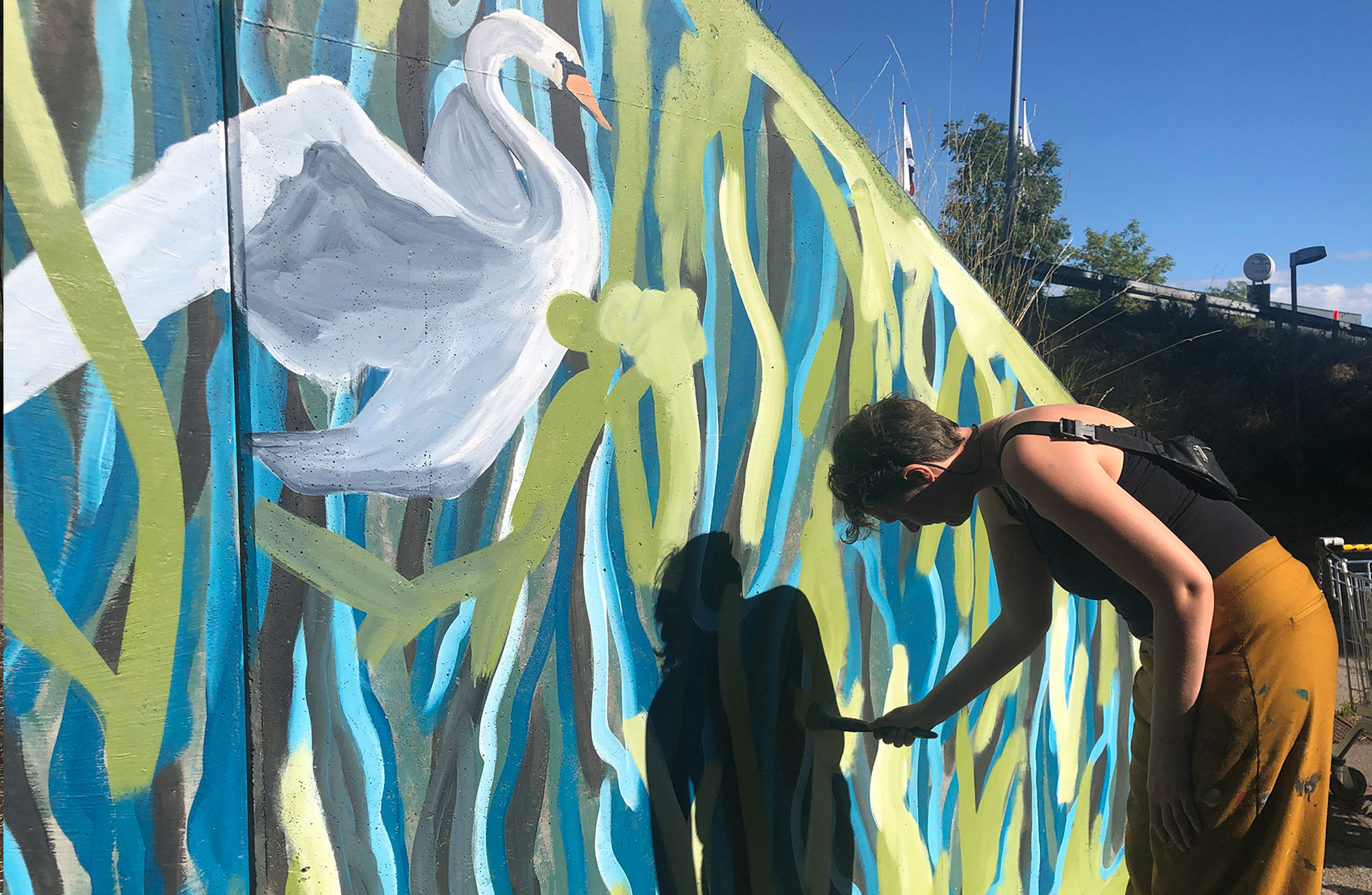
PORTRAIT 2023
Written by Sisse Siggaard Jensen
Cand.mag. & dr.phil.
“Abstract art entices us to go beyond the surface, to delve into the layers of meaning and
Mia-Nelle Drøschler, Ambæk Mark
symbolism that lies beneath. It is a language of the soul, where words fail and feelings speak volumes.”
A FARM ON AMBÆK MARK
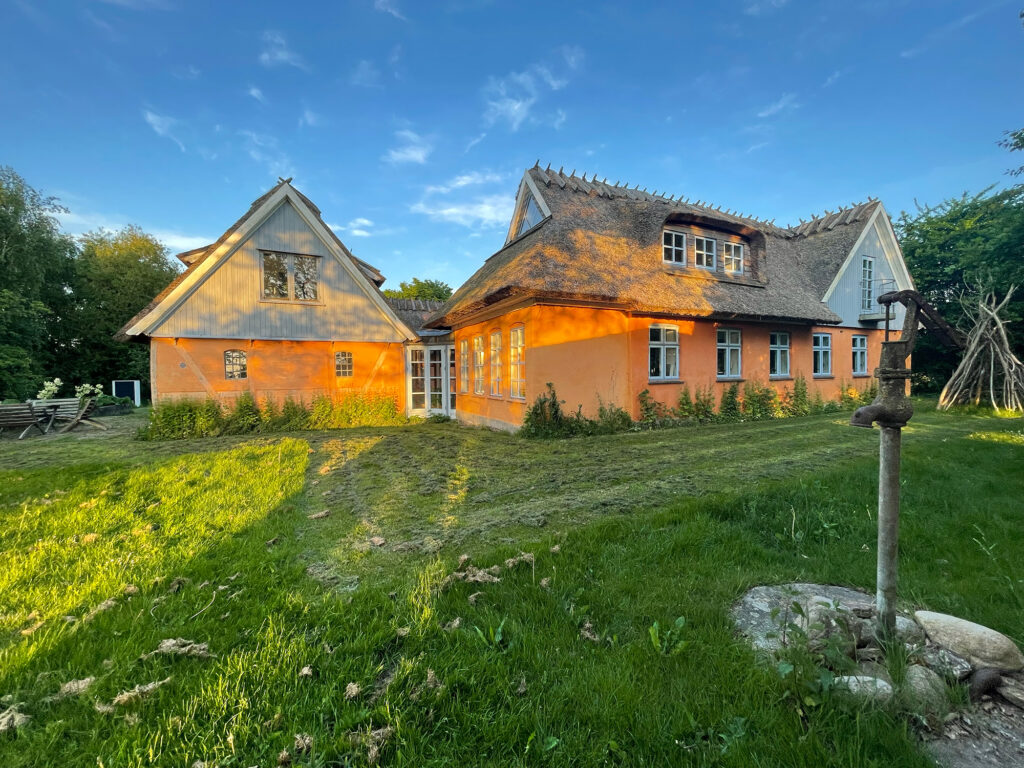
It was a windy day; I had to keep my hat and glasses on when I got out of my car to
interview Mia-Nelle, who is a newly moved artist at Jungshoved, mind you, if you can
call it newly moved in when it’s been well over 2 years since Mia-Nelle moved here. It had become too expensive to have both a studio and a home in Copenhagen, so Mia-Nelle and her husband Svenn returned the look towards the more rural – first in the direction of North Zealand, but gradually also Sydsjælland and finally Jungshoved. Out in the field with high to the sky and surrounded by fields is the farm on Jungshoved that she eventually chose to move into with her husband and a little one curious and attentive dog.
The farm lies with distances and air around it; it creates the calmness that is so crucial for Mia-Nelle in working with her art. In an outbuilding to the farm, I find Mia-Nelle, who is working on one of her many and diverse works of art in the studio.
MULTI-ARTIST
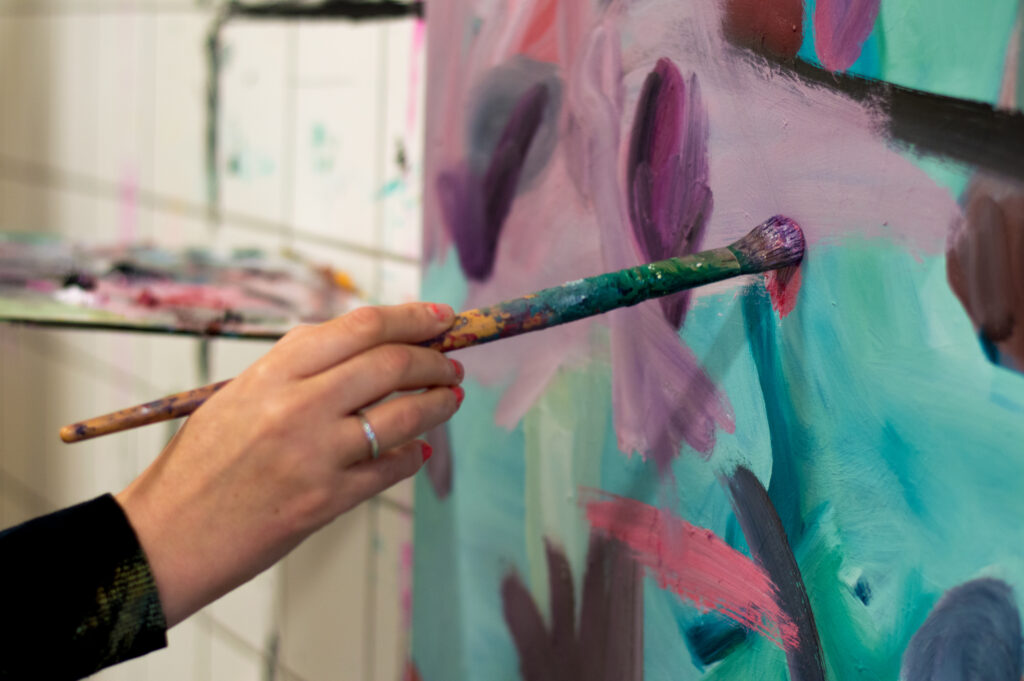
Mia-Nelle is a multi-artist who ranges widely when she weaves with threads of paint or others materials that create artistic expressions drawn from such diverse art forms as abstract painting on canvas and on walls, sculptures and poems with illustrations – she has a long list on her CV references to all the many exhibitions, grants and stays at foreign institutes, for example the Danish Institute in Rome, which has shaped the journey along the way to become an experienced artist. Not only paintings on canvas have inspired her work, which, as mentioned, she has also embarked on large public murals such as “It’s time Holger Danske wakes up”, in collaboration with Helsingør municipality (2019) and “Under the surface the sky is always blue,” in Copenhagen municipality (2016).
The murals require ideas and visions and painting techniques that make it possible to translate the visions into reality large pictorial weavings that almost resemble tapestries. You sense that concentration and physical energy that is needed when it is up and down stairs many, many times, while ideas and visions drive the process forward. Mia-Nelle’s pictures are often in large formats, it’s in big arm movements she paints, so the murals make a lot of sense when you also know hers other arts.
There are also poems with illustrations on the CV – the collection of poems “Love, love, love” (2022) was published by the publishing house Silkefyret – Mia-Nelle actually wanted to become a writer as a child, but she changed direction after teaching visual arts at the end of primary school – funnily enough, she stayed taught by the artist who designed the mural on the former Merchant’s Yard in Jungshoved City. As if that is not enough, she has also added sculpture and performance to her artistic expression.
HARD SCHOOL
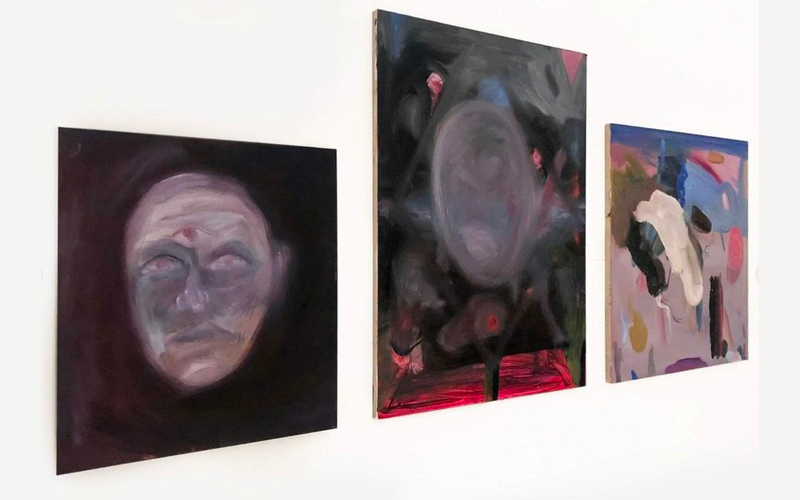
One should not be mistaken; behind the dynamic and abstract expression lies a network of knowledge and experiences that are the result of “hard schooling.” Mia-Nelle draws on knowledge of color theory, composition, perspective, materials, and she has many years of experience in translating this knowledge into paintings through painting techniques and craftsmanship. It is a knowledge and foundation that allows her as an artist to seek new paths, experiment with new materials, new forms of expression, but with a grounding in classical theory and practice. A foundation she gained during her education, which concluded in 2010 at “Fine Art,” Goldsmiths University of London – an internationally recognized art institution.
THE “LANGUAGE” OF THE SOUL
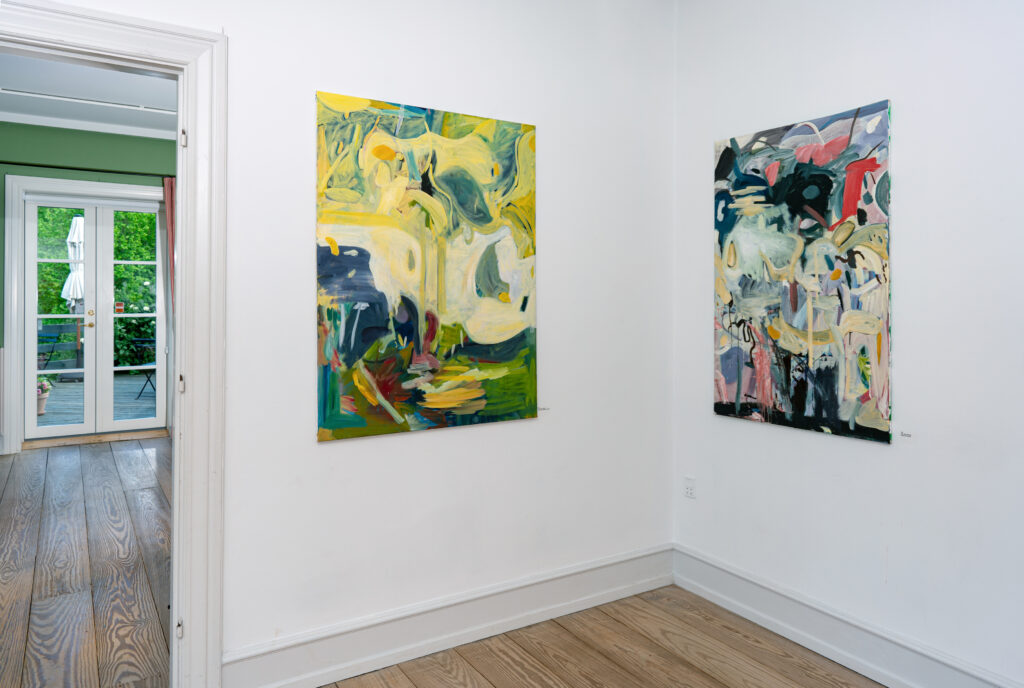
A work of art is, in essence, an exploration of a concept; it is with the concept and the colors that the paintings begin, says Mia-Nelle. There is an exploration of existential life questions both behind and in her paintings, where especially the colors speak a language of the soul; subconscious and intuitive aspects of our lives speak through the colors, as she expresses it: “Kandinsky paints the soul,” so the spiritual is the concept Mia-Nelle is currently exploring; but not in a religious sense, rather as the spiritual that conveys that we as humans connect with each other and with nature. It can be described as Mia Nelle’s quest for subconscious and collective experiences shaped as archetypal figures inspired by depth psychology as formulated by psychiatrist C.G. Jung (1875-1961).
A work therefore starts with a concept that must be explored, and a choice of colors. This is done concretely by Mia-Nelle choosing several color palettes, which are placed in different parts of the studio as a prerequisite for starting work on creating the abstract universes. Colors mean everything. She formulates it in this way:
“I am convinced that if, unfortunately, my house were to burn down one day, I would jump into the flames to save my color library [self-mixed colors] as the only thing. I see the colors as my DNA in all the paintings I create. That’s how important it is for me to mix my own colors and keep them.
The style has previously been an exploration of the figurative-surreal, but now it is more of an intuitive and abstract-impressionistic essence that runs through the painterly universes. And the intuitive and dynamic is created, among other things, by constructing perspective through the use of colors, unfolding in a wealth of broken, round, angular, mirrored surfaces combined with structures of backgrounds, mid-grounds, and foregrounds, where light colors, for example, can form the background and the dark ones the foreground. In the creation of the abstract paintings, Mia-Nelle no longer makes sketches before starting the painting; working with sketches is a training and a method that is so ingrained that it can work in the very activity of painting, so it grows out of the movement and dynamics. Her professor at the art academy in London could demand 63 sketches before she could start a painting, so it was a tough school.
THE POWER OF THE EGO
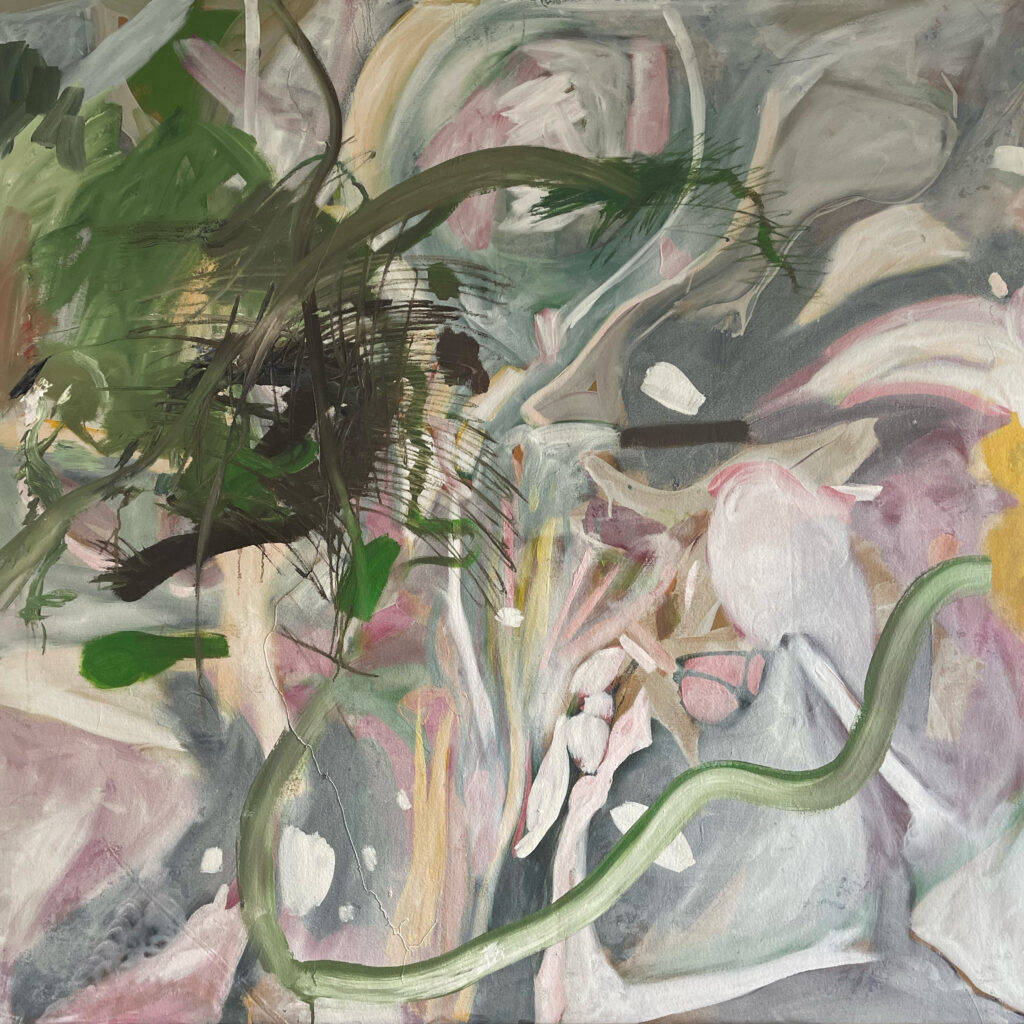
Exploration of the ego is an example of the creative process Mia-Nelle is currently engaged in; an exploration that she comments on with the statements: “It’s all about me, it’s all about me, it’s all about me;” the power of the ego is so frightening, she says: “… I have to fight with it every morning when I wake up, I want to be the most famous artist of all time;” so she has removed the word “career” from her vocabulary and instead works on exploring what makes sense in relation to the chosen concept given the current zeitgeist.
THE GALLERY INDUSTRY
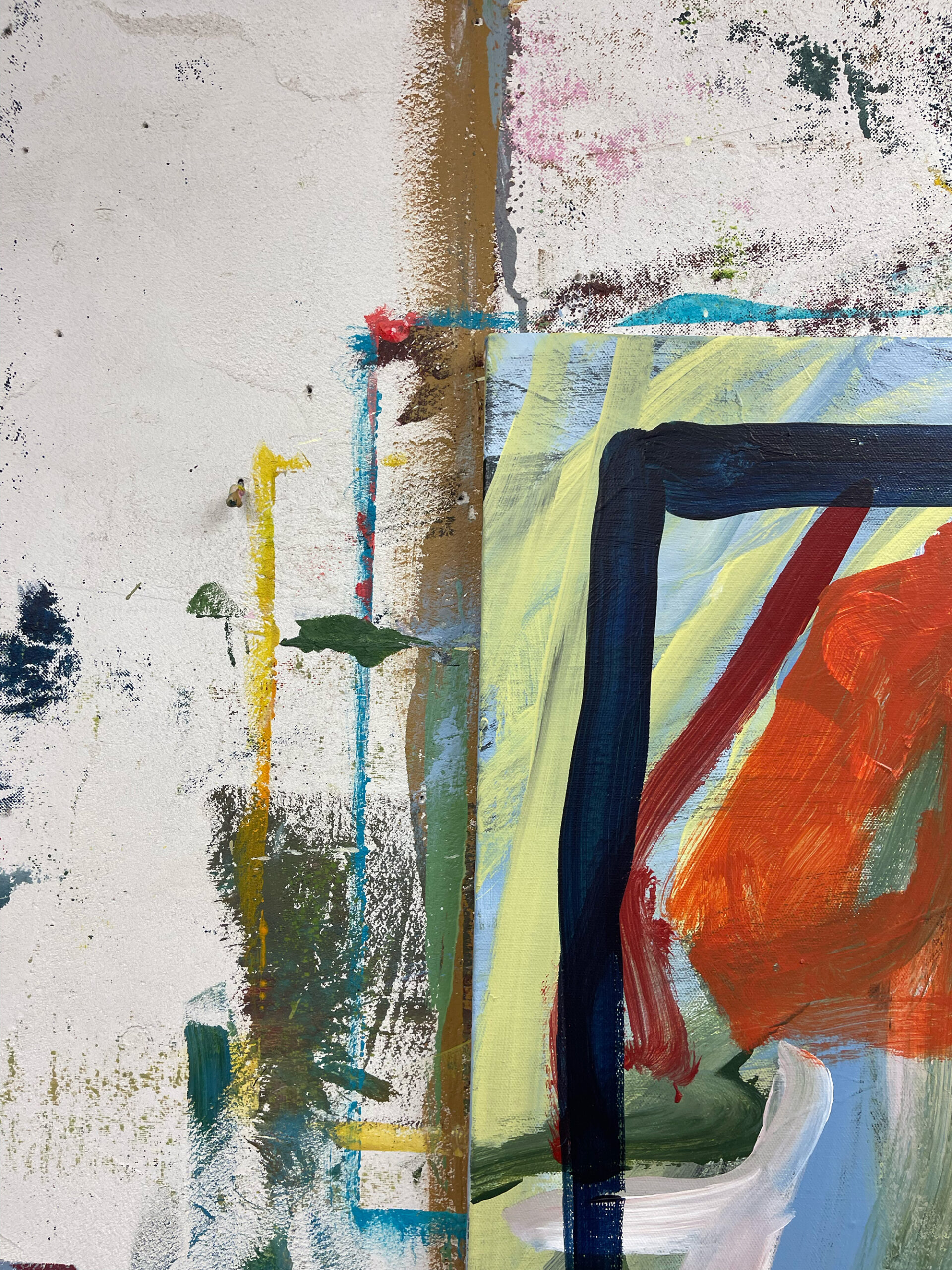
But it brings problems when the artistic expression has so many different forms; it makes it difficult to be recognizable as an artist, and it makes it harder to sell one’s paintings. Many galleries prefer a very recognizable expression: “… this is a Mia-Nelle,” so it can be difficult to be allowed to follow one’s own artistic path. In general, Mia-Nelle stays away from what she calls the gallery industry. When an artist becomes a part of a gallery, it facilitates marketing and sales, but it can also lead to adaptation to the gallery’s interests rather than to the artistic expression. So, there is nothing else to do but to be constantly proactive, visit many different galleries and exhibitions, and participate yourself. It is a time-consuming process, it requires a lot of energy investment, but it is necessary when striving to make art a livelihood. It has eased Mia-Nelle’s situation to become a member of “Corner – the artists’ association,” which opens up a network of good contacts as well as the opportunity to participate in regular exhibitions.
THE BOOK “LEARN TO PAINT”
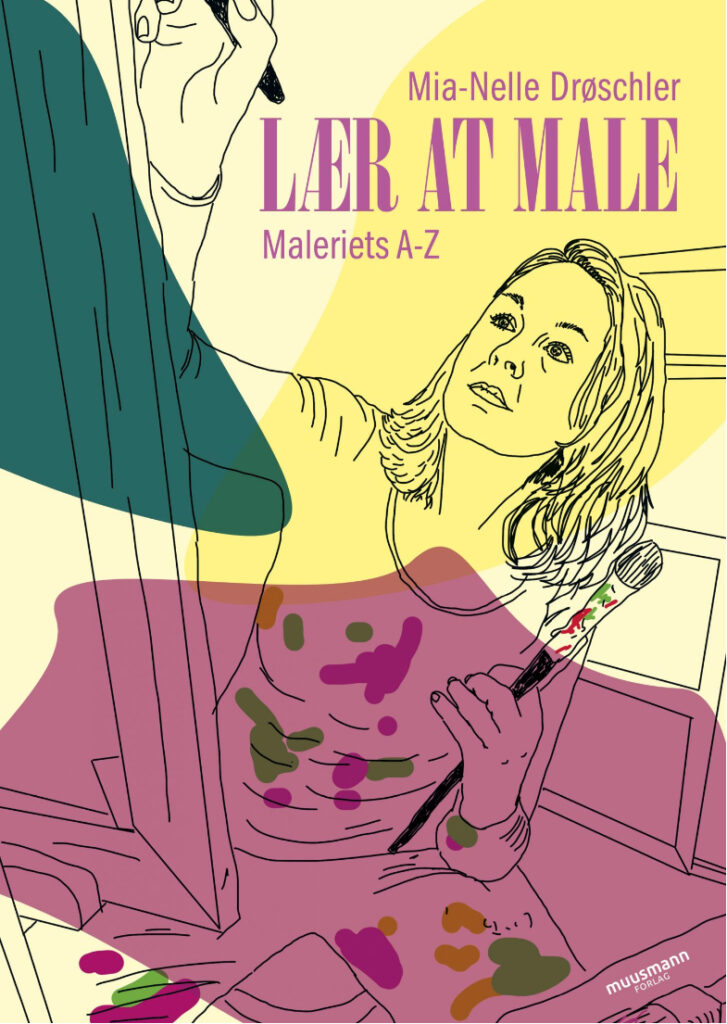
The pandemic meant that Mia-Nelle had to cancel exhibitions. It was a setback that was difficult to handle. Therefore, she decided to write a book with a concentration of her knowledge, education, and years of experience. With the simple and straightforward title: “Learn to Paint,” she goes through some of the most important aspects and steps in the process of learning to paint. And she has developed a method in the learning process, a method that structures the entire layout of the book and the many concrete tasks that are part of the learning process’s many possible paths. The book is richly illustrated with her own drawings. The content is not only based on her own experiences, as Mia-Nelle has many years of experience with various forms of teaching; this applies to both aspiring artists preparing to apply to the Art Academy and students who simply want to enrich their immediate joy of painting and shaping. She holds workshops lasting 3 or 5 days; they are workshops with a few students, all of whom are accommodated in her studio, and in recent times, she has also worked on expanding her workshops with an online art school. Visit Mia-Nelle’s website; it is full of exciting thoughts and art, and you can keep up with the announcements of her workshops and exhibitions.